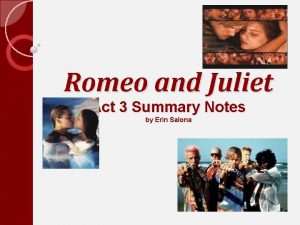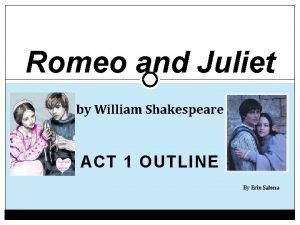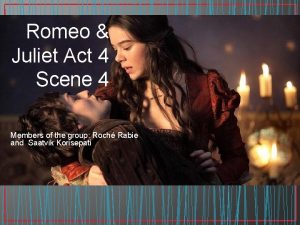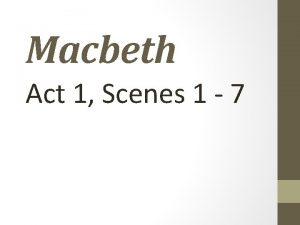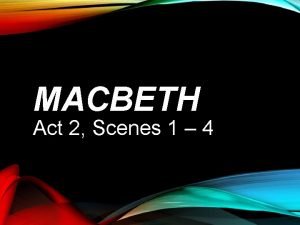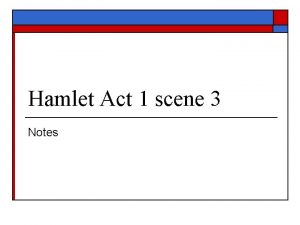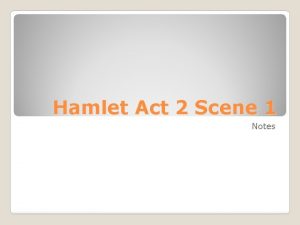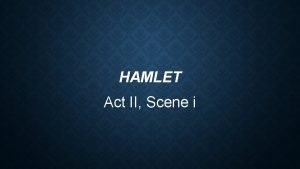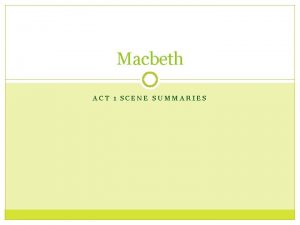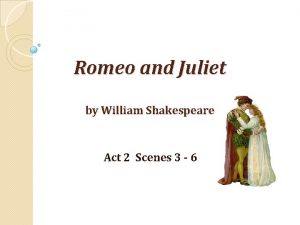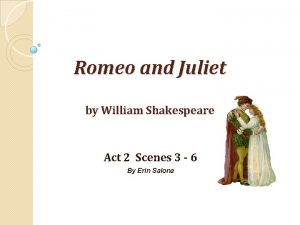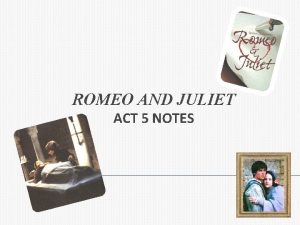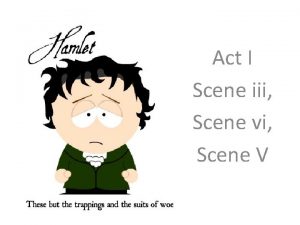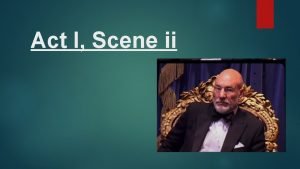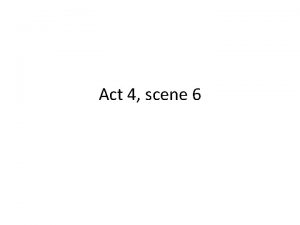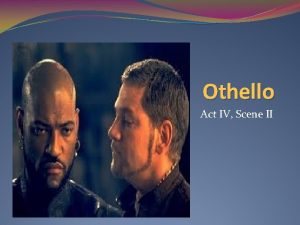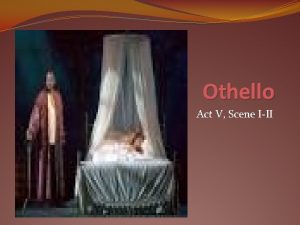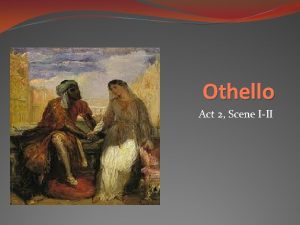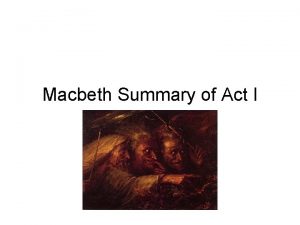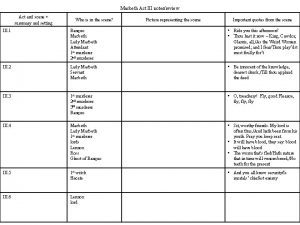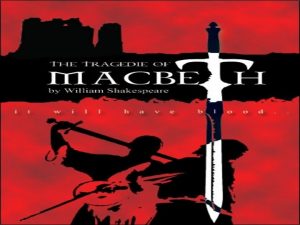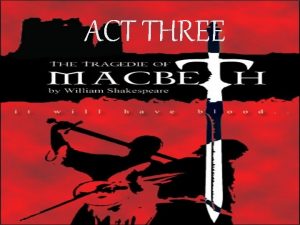Act 1 Scene 1 Summary and analysis Setting















- Slides: 15

Act 1, Scene 1 Summary and analysis

Setting A “guard platform of the castle” We are on the battlements Scene notes: in the Globe, remember that it is broad daylight and probably the middle of summer Darkness Cold is imagined

Act 1, Scene 1 Typical Shakespearean tragedy: main character not in first scene e. g. – Romeo and Juliet with the two Capulet soldiers and the two Montague soldiers e. g. Most – Macbeth with the witches of the comedies do not do this (e. g. – Orsino in Twelfth Night opens the play, and he is a main character; the lovers are in the first scene of Midsummer)

Act 1, Scene 1 The mood is one of uncertainty First line: Barnardo: Who’s there? – line 1 Sets up a main theme in the play: we cannot trust anything or anyone Appearance, sight

Act 1, Scene 1 • What do we know right away? We are in a castle We are in a place that has a king (Barnardo: Long live the King! – line 3) It’s dark; it’s midnight (Barnardo: ’Tis now struck twelve. – line 7) It is a castle that needs to be guarded for some reason It’s cold (Francisco: ’Tis bitter cold, / And I am sick at heart – lines 8 -9) Nothing has happened, but they feel that something could happen (again, the “sick at heart” business) More men are expected We are in Denmark (Marcellus: And liegemen to the Dane. – line 15); specifically, Kronborg Castle in a place called Elsinore (Anglicized version of Helsingør) The new men are expecting a ghost to appear (Marcellus: What, has thing appeared again tonight? – line 21)

Act 1, Scene 1 Horatio The most important character in the scene Hamlet’s He best friend is a “scholar” (line 42) He is very careful with his language, and tries at all times to speak as exactly as he can He doubts the ghost until he can verify the guards’ report with his own eyes; he is there to “approve [the guards’] eyes” (line 29)

Act 1, Scene 1 The ghost Elizabethan A beliefs about ghosts: ghost could be the spirit of a dead person, but it did not have to be Apparently some ghosts could be demons or devils that trick the living into thinking that they are dead relatives; this is a source of one of Hamlet’s biggest delays in killing Claudius later It is “a spirit that can take on any shape for any purpose” (Asimov, vol. II, p. 82)

Act 1, Scene 1 It is “In the same figure like the king that’s dead” (line 41 – italics added) It looks like the dead king, but they are not convinced it is the dead king Horatio says that is has “usurp[ed]” King Hamlet’s “fair and warlike form” (lines 46 -47) Apparently the dead King Hamlet was a great warrior Horatio first sees it as a warning about something bad that is going to happen “This bodes some strange eruption to our state” (line 69) Being a scholar, he comes up with a historical precedent: In Caesar’s time, close to the time of his assassination, “the sheeted dead / Did squeak and gibber in the Roman streets” (lines 115 -116) Shakespeare had just written Julius Caesar at some point in the two or three years preceding Hamlet, so it was on his mind

Act 1, Scene 1 The Ghost Ominous presence suggests the upsetting of the balance of nature Bernardo Horatio & Marcellus wait to show Horatio declares that the ghost must bring warning of impending misfortune for Denmark, perhaps in the form of a military attack. (has same armour and expression as when he battled Normans and Poles)

Act 1, Scene 1 The ghost Horatio in particular sees the ghost as an ill omen boding violence and turmoil in Denmark’s future, comparing it to the supernatural omens that supposedly presaged the assassination of Julius Caesar in ancient Rome (and which Shakespeare had recently represented in Julius Caesar).

Act 1, Scene 1 The ghost Since Horatio proves to be right, and the appearance of the ghost does presage the later tragedies of the play, the ghost functions as a kind of internal foreshadowing, implying tragedy not only to the audience but to the characters as well.

Act 1, Scene 1 Horatio’s speech (lines 79 -108) Lots of exposition King Hamlet killed the King of Norway, a man called Fortinbras (a French name meaning “strong in arm”) Doing this gave Denmark control over Norway The Norwegian King’s son, also called Fortinbras, is trying to get his father’s kingdom back o. We will eventually meet this character o. Think of him as being in the background for the entire play o. Denmark is in a state of readiness for war; modern analogies? This is Horatio’s explanation for why it appears Denmark is preparing for war (and also for the need to guard the palace heavily)

Act 1, Scene 1 The ghost will not speak, and it is gone with the coming of the morning Night versus day; dark versus light – common symbolic ideas o. Night: dark, bad, unwholesome o. Day: light, good, “wholesome” – line 162 Horatio again repeats his assertion that this visitation is a bad thing for the country Asimov’s point: we must remember how frightening the nights must have been before the time of artificial light o. Night made people open to suggestion; it is easy to believe in ghosts in an environment like that (cf. – Blair Witch story) o. Also, no clocks in medieval Denmark either

Act 1, Scene 1 Mention is made, finally, of the main character six lines before the end of the scene, and plans are made to go and see him

Act 1, Scene 1 Hamlet was written around the year 1600 in the final years of the reign of Queen Elizabeth I, who had been the monarch of England for more than forty years and was then in her late sixties. The prospect of Elizabeth’s death and the question of who would succeed her was a subject of grave anxiety at the time, since Elizabeth had no children, and the only person with a legitimate royal claim, James of Scotland
 3°
3° Why does benvolio want to crash the party
Why does benvolio want to crash the party Act 4 scene 4 summary romeo and juliet
Act 4 scene 4 summary romeo and juliet Macbeth act 1 summary scenes 1-7
Macbeth act 1 summary scenes 1-7 Othello act 1 scene 2 analysis
Othello act 1 scene 2 analysis Macbeth act 2 setting
Macbeth act 2 setting Summary of hamlet act 1 scene 3
Summary of hamlet act 1 scene 3 Hamlet act 2 scene 1 summary
Hamlet act 2 scene 1 summary Othello act 2 scene 1 analysis
Othello act 2 scene 1 analysis Hamlet act ii scene 1
Hamlet act ii scene 1 Macbeth act one summary
Macbeth act one summary Chain me with roaring bears analysis
Chain me with roaring bears analysis What is act 2 scene 3 about in romeo and juliet
What is act 2 scene 3 about in romeo and juliet Romeo and juliet act 2 scene 3 summary
Romeo and juliet act 2 scene 3 summary Romeo and juliet act 5, scene 3 summary
Romeo and juliet act 5, scene 3 summary Romeo and juliet consequences
Romeo and juliet consequences
